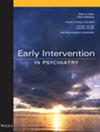How Do Youth Interpret Self-Report Questions Screening for Psychosis? Insights From Cognitive Interviewing
Abstract
Introduction
Early detection of psychosis can facilitate earlier intervention and improve mental health outcomes. However, self-report screens probing specific and non-specific experiences related to psychosis and psychosis risk can yield high rates of false positive screens. We conducted cognitive interviews with youth who had completed a self-report psychosis screen to explore item misunderstanding as a reason for these false positives.
Methods
We interviewed 13 racially and ethnically diverse patients ages 14–21 from an urban adolescent and young adult medicine clinic. Master's-level clinicians asked participants to rate the degree to which they thought they understood each item and to describe the item in their own words. Two independent raters used deductive coding to rate participant understanding and inductive coding to identify types of understanding and misunderstanding.
Results
Participants had high confidence that they understood the items (mean of 8.1 out of 10) but were rated as understanding items as intended only 42% of the time. Two major types of misunderstanding were identified: (1) as a non-psychotic mental health experience and (2) as a developmentally or contextually normative experience.
Conclusion
Our results identify sources of misunderstanding that may lead youth to falsely endorse self-reported psychosis screening items. Unless or until items are known to be well-understood, it is imperative that positive screens receive clinical follow-up to explore the responses in light of each person's medical, developmental and social context. Future research is needed to improve item wording for readability and clarity and to test strategies for minimising risk of false positive screening results.


 求助内容:
求助内容: 应助结果提醒方式:
应助结果提醒方式:


